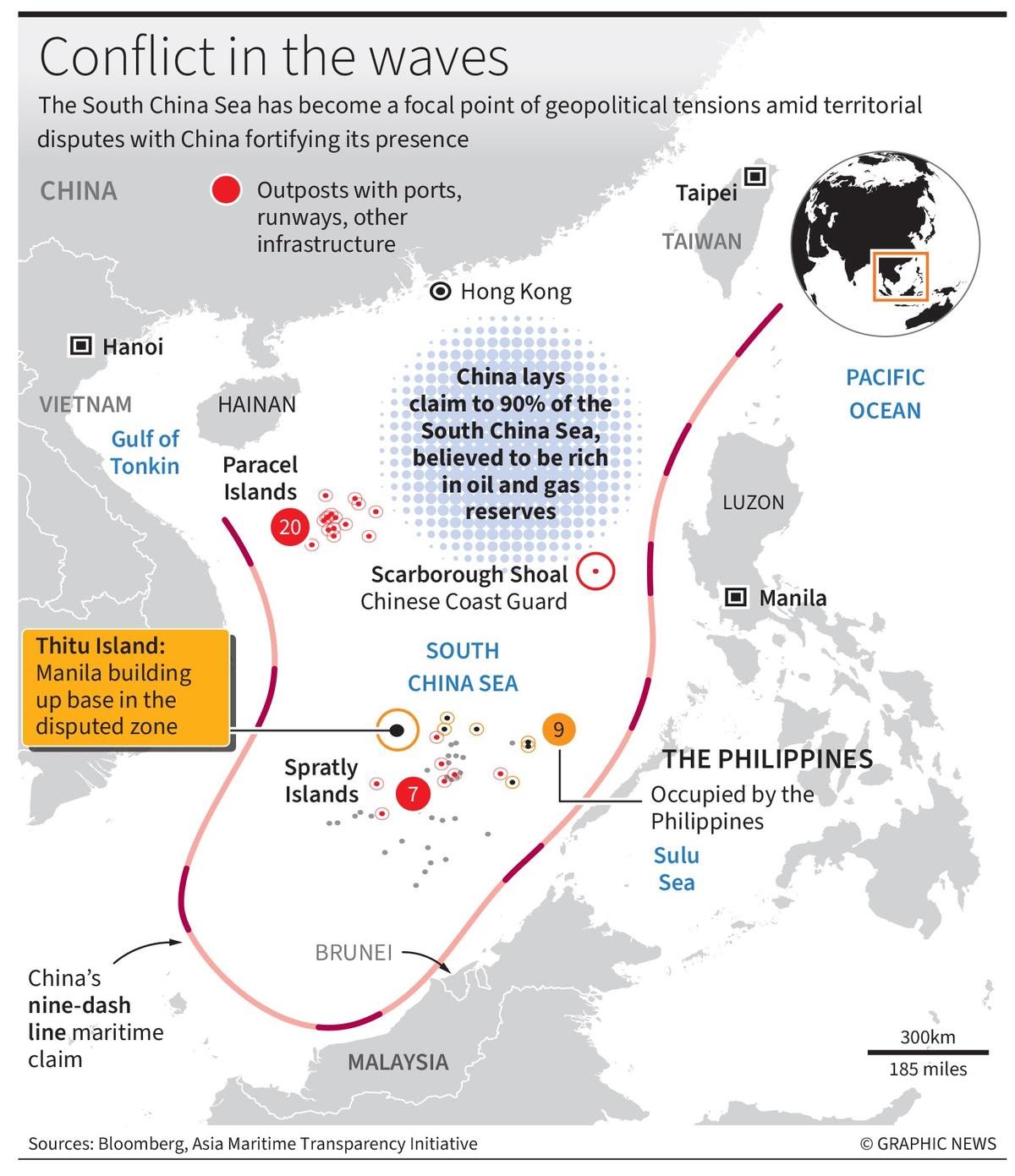SOUTH CHINA SEA

- 28 Sep 2024
In News:
In recent years, maritime East Asia has emerged as a battleground for intensified power politics, particularly in the East China Sea and the South China Sea. These regions involve complex territorial disputes and geopolitical tensions, particularly concerning China, Japan, Taiwan, and several Southeast Asian nations.
Geographic and Strategic Significance
East China Sea
- Territorial Claims: The East China Sea borders China, Taiwan, Japan, and South Korea, with the Senkaku/Diaoyu islands being a focal point of contention.
- Crises: Multiple crises have erupted over these islands, reflecting deep-seated national interests.
South China Sea
- Key Players: Located between China, Taiwan, and five Southeast Asian countries—Vietnam, Malaysia, Brunei, the Philippines, and Indonesia.
- Flashpoint: This area has become a critical flashpoint in the Indo-Pacific, with China aggressively asserting its claims.
China's Motivations
Naval Exercises and Claims
- Naval Collaboration: China has conducted naval exercises with Russia in the South China Sea, showcasing military capabilities and reinforcing territorial claims.
- Legal Standing: Despite a 2016 ruling by a permanent court of arbitration declaring China's claims to lack legal basis, Beijing has rejected this decision.
Regional Responses to China's Actions
1. Enhancing Defence Capabilities
- Increased Defence Spending: Countries like Japan and the Philippines are significantly boosting their defence budgets, with Japan aiming to double its spending by 2027.
- Acquisition of Technology: The Philippines has acquired anti-ship BrahMos missiles from India as part of its defence enhancement efforts.
2. Addressing Maritime Activities
- Shift in Policy: The Philippines has pivoted from a conciliatory approach to actively publicizing confrontations with Chinese vessels.
- Public Diplomacy: The Philippines employs social media to document and share encounters with Chinese ships, shaping public perceptions.
3. Strengthening Alliances
- U.S. Cooperation: The Philippines, Japan, and South Korea are reinforcing their defence relationships with the U.S., expanding cooperation in various domains including joint exercises.
- Trilateral Meetings: The U.S., Japan, and South Korea have deepened their trilateral cooperation, addressing concerns about unilateral changes to the status quo in the Indo-Pacific.
U.S. Credibility and Strategic Implications
Despite efforts to bolster alliances, concerns remain regarding U.S. credibility and the impact of domestic politics on its international commitments. There is ongoing debate over whether U.S. engagement balances Chinese power or exacerbates tensions.
China’s Sovereignty Perspective
National Security Framework
- Defence White Paper: China's 2019 Defence White Paper emphasizes that the South China Sea islands and Diaoyu Islands are integral parts of its territory.
- Infrastructure Development: China claims its actions are defensive, building infrastructure and conducting patrols, while regional nations view these actions as provocative.
Economic Importance of the Seas
- Maritime Trade Routes: Key maritime trade routes in East Asia traverse these waters, with the Taiwan Strait being a critical choke point.
- Resource Richness: The region contains vast reserves of untapped oil and natural gas, making it economically significant.
China's Aggressive Tactics
Infrastructure and Militarization
- Building Facilities: China is constructing military installations and artificial islands in both the East and South China Seas.
- Conflict with Japan: China has frequently contested Japanese claims, resulting in significant diplomatic and military tensions.
South China Sea Belligerence
- Power Asymmetry: China's navy is the largest in the world, enabling it to project power effectively in the South China Sea.
- Aggressive Maneuvers: Tactics include harassment of resupply missions, ramming vessels, and the use of military-grade lasers.
Recent Escalations in the South China Sea
- Increased Incidents: Since 2022, clashes between China and the Philippines have intensified, especially around Second Thomas Shoal and Sabina Shoal.
- Dangerous Encounters: China's larger Coast Guard vessels pose significant risks during confrontations, raising concerns about potential miscalculations.
Conclusion
The evolving power dynamics in maritime East Asia highlight the interplay of national interests, regional security, and international cooperation. The situation remains fluid, with significant implications for global trade, security, and diplomatic relations. Understanding these complexities is essential for addressing the challenges posed by an assertive China and fostering stability in the region.
